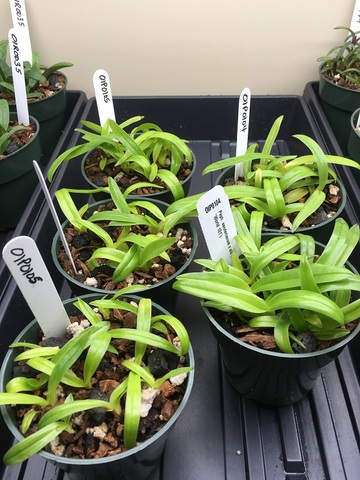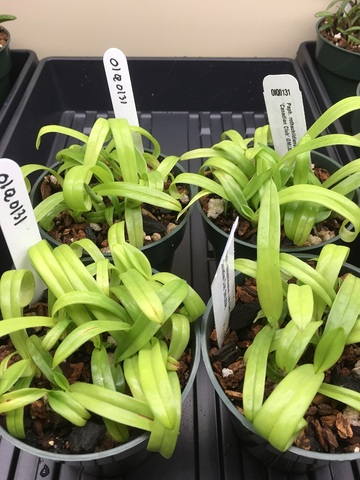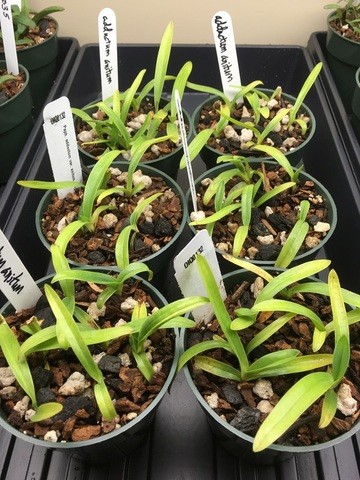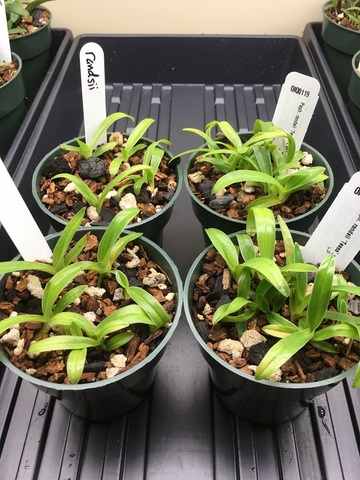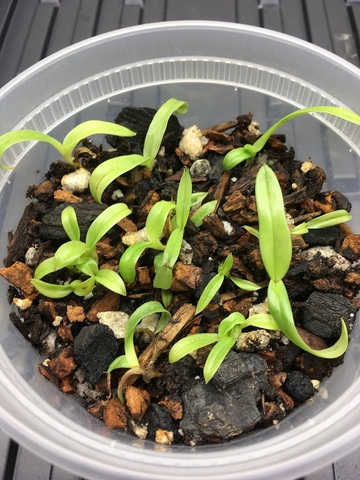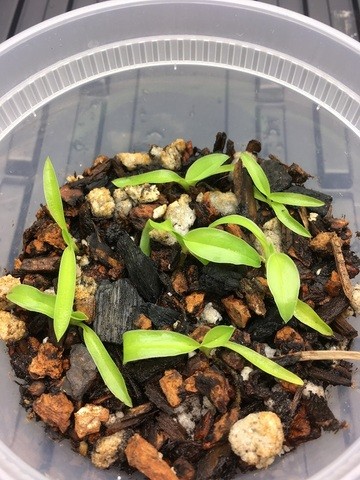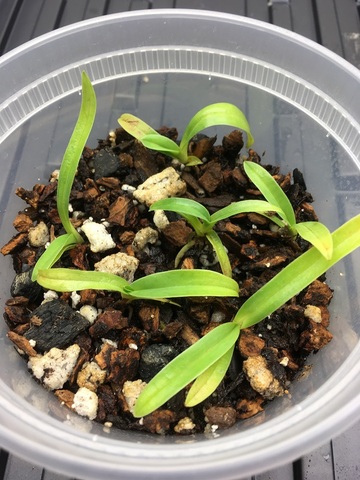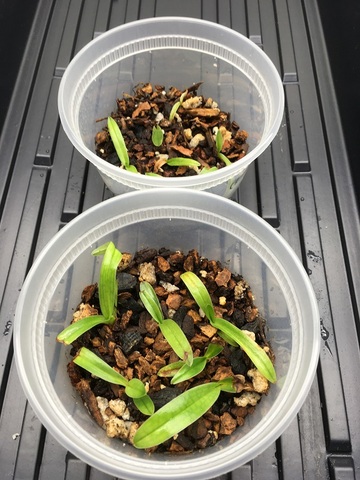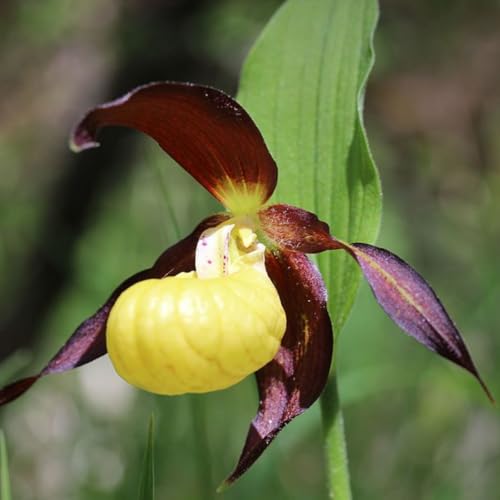The Coryopedilum Chronicles VI – Three month status review
This Chronicle documents the status of two flasks each of Paphiopedilum sanderianum, rothschildianum, platyphyllum, adductum v. anitum and randsii three months after they were deflasked and placed into compots.
In Chronicles VI, there are two new additions- freshly deflasked single flasks of Paphiopedilum adductum and praestans.
The status of each species is presented in a separate section, along with photographs, with the hospital compots covered separately following the species sections.
IMPORTANT PHOTOGRAPHY NOTE – With apologies, these pictures are far more yellowish than reality, and moreso than prior Chronicles. Perhaps the fact the lighting is now closer to the plants is making photography more difficult. In any event- everything is a good light grass green except the randsii and praestans which are a more rich emerald green.
Growing conditions - updated
The compots are all together on multiple shelves in a single shelving unit in a bathroom- so no natural light. Artificial light is provided by four Phillips T8 32W 48” Natural Light bulbs, 2850 lumens, 5000k bulbs that were approximately 18 inches above the leaves until a month ago. Now all plants are approximately 12 inches from the lights, save for a selection of platyphyllum and randsii which are being tested out at 9 inches from the lights.
A month ago the watering regime was also adjusted from RO water to City of Dallas tap water. With the ease of watering from the tap, waterings can be more thorough and are now performed three times a week instead of four times a week. This holds for the adductum v. anitum and randsii which were previously receiving extra waterings. All plants are misted each morning with RO water. The plants have all responded very favorably to this change- I think more due to the improved watering process than to any nutritional value that may come from tap versus RO water.
No fertilizers or other supplements have been applied, and at this point none are planned for the foreseeable future.
Temperature and humidity are monitored on an ongoing basis. Previously, in the immediate growing area the temperature was very consistently at a low of 72 overnight and a high of 75 during the day. About a month ago, the shelf heights were shortened to convert the bottom shelf from storage to an additional growing area. With the reduced shelf height and added lighting, day temps are now running a high of 77, with no change at night.
Humidity dropped a bit with the shelving changes. Previously, it fluctuated between a low of 53-55 degrees during the day and a high of 63-65 degrees at night. Now the daytime lows are in the upper 40s and night time highs are around 60.
I make note of the above because I was surprised the degree to which temperatures and humidity levels changed when the plants were moved closer to the lights, plus a new growing shelf (and thus two more light fixtures) was added. To my knowledge, there were no external environmental adjustments that could explain these changes.
As of one month ago, all hospital compots have had their lids permanently removed to adjust the plants for traditional compotting in the near future.
New additions
As noted in the introduction, about two weeks ago single flasks of Paphiopedilum adductum and praestans were added to the mix.
Here is a photo of the two compots of praestans. They have been worry free from day one- lovely plants that adapted very quickly to the outside world without missing a beat. Potted with agar intact.
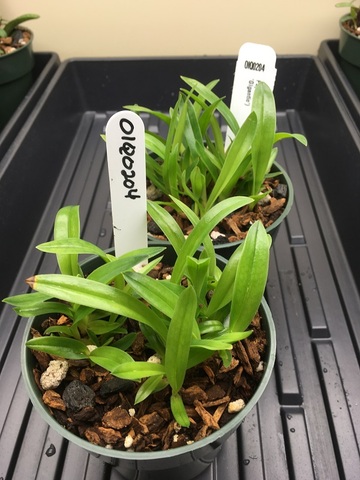
The adductum were another matter, and I am now thoroughly convinced that adductum (as well as adductum v. anitum) must be deflasked as soon as possible, and potted into compots with all the agar removed. I did not think to take a photo when the flask arrived, but I let it sit open for a few days to adjust prior to potting as I have done with all the other flasks. About 3 days later the plants (which were small to begin with) very suddenly dried out and nearly died.
I immediately removed the agar and put them all into hospital compots with intense daily misting. Five days later, most of them had made a full recovery, but four plants were lost. Here they are now- a long road ahead, but most should make it and be fine. I expect these will be in hospital compot for at least three months.
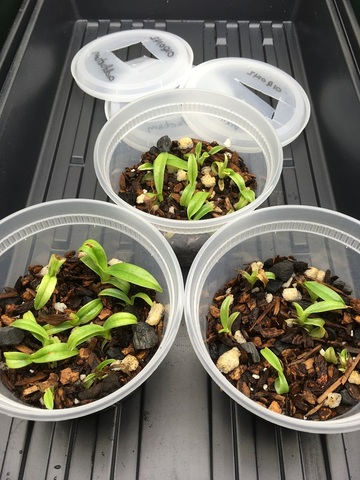
Agar intact versus agar removed in compotting – a new opinion
This will be covered in more detail below with reviews of each species, but I wanted to make special note of the fact that three months after deflasking I am now seeing a noticeable difference- for the better- with compots that were potted with agar intact versus with agar removed. I do not think the latter plants will suffer in the long term, but in the interim most plants seem to be doing better where the agar was left intact. The notable exception to this is adductum v. anitum, which is explained below.
The magic question is the extent to which this improved performance is due to one or more of the following,
-residual nutritional benefits granted by the agar,
-the presence of the agar making a more gradual transition to life outside of flask, or
-the fact the agar-intact method is less damaging to the plants and reduces root breakage during compotting.
I do not have an answer- but the method is working out quite well, and I am now using it on all Paphiopedilum flasks save for adductum and adductum v. anitum.
Plant losses defined
One of the statistics reported below in each section is plant loss. Please know that I define a “plant” as having at least two leaves and at least one good root. In any flask, you will always lose some or all of the really tiny plants that have not rooted well. And so I am not including them in the reported plant losses.
This Chronicle documents the status of two flasks each of Paphiopedilum sanderianum, rothschildianum, platyphyllum, adductum v. anitum and randsii three months after they were deflasked and placed into compots.
In Chronicles VI, there are two new additions- freshly deflasked single flasks of Paphiopedilum adductum and praestans.
The status of each species is presented in a separate section, along with photographs, with the hospital compots covered separately following the species sections.
IMPORTANT PHOTOGRAPHY NOTE – With apologies, these pictures are far more yellowish than reality, and moreso than prior Chronicles. Perhaps the fact the lighting is now closer to the plants is making photography more difficult. In any event- everything is a good light grass green except the randsii and praestans which are a more rich emerald green.
Growing conditions - updated
The compots are all together on multiple shelves in a single shelving unit in a bathroom- so no natural light. Artificial light is provided by four Phillips T8 32W 48” Natural Light bulbs, 2850 lumens, 5000k bulbs that were approximately 18 inches above the leaves until a month ago. Now all plants are approximately 12 inches from the lights, save for a selection of platyphyllum and randsii which are being tested out at 9 inches from the lights.
A month ago the watering regime was also adjusted from RO water to City of Dallas tap water. With the ease of watering from the tap, waterings can be more thorough and are now performed three times a week instead of four times a week. This holds for the adductum v. anitum and randsii which were previously receiving extra waterings. All plants are misted each morning with RO water. The plants have all responded very favorably to this change- I think more due to the improved watering process than to any nutritional value that may come from tap versus RO water.
No fertilizers or other supplements have been applied, and at this point none are planned for the foreseeable future.
Temperature and humidity are monitored on an ongoing basis. Previously, in the immediate growing area the temperature was very consistently at a low of 72 overnight and a high of 75 during the day. About a month ago, the shelf heights were shortened to convert the bottom shelf from storage to an additional growing area. With the reduced shelf height and added lighting, day temps are now running a high of 77, with no change at night.
Humidity dropped a bit with the shelving changes. Previously, it fluctuated between a low of 53-55 degrees during the day and a high of 63-65 degrees at night. Now the daytime lows are in the upper 40s and night time highs are around 60.
I make note of the above because I was surprised the degree to which temperatures and humidity levels changed when the plants were moved closer to the lights, plus a new growing shelf (and thus two more light fixtures) was added. To my knowledge, there were no external environmental adjustments that could explain these changes.
As of one month ago, all hospital compots have had their lids permanently removed to adjust the plants for traditional compotting in the near future.
New additions
As noted in the introduction, about two weeks ago single flasks of Paphiopedilum adductum and praestans were added to the mix.
Here is a photo of the two compots of praestans. They have been worry free from day one- lovely plants that adapted very quickly to the outside world without missing a beat. Potted with agar intact.

The adductum were another matter, and I am now thoroughly convinced that adductum (as well as adductum v. anitum) must be deflasked as soon as possible, and potted into compots with all the agar removed. I did not think to take a photo when the flask arrived, but I let it sit open for a few days to adjust prior to potting as I have done with all the other flasks. About 3 days later the plants (which were small to begin with) very suddenly dried out and nearly died.
I immediately removed the agar and put them all into hospital compots with intense daily misting. Five days later, most of them had made a full recovery, but four plants were lost. Here they are now- a long road ahead, but most should make it and be fine. I expect these will be in hospital compot for at least three months.

Agar intact versus agar removed in compotting – a new opinion
This will be covered in more detail below with reviews of each species, but I wanted to make special note of the fact that three months after deflasking I am now seeing a noticeable difference- for the better- with compots that were potted with agar intact versus with agar removed. I do not think the latter plants will suffer in the long term, but in the interim most plants seem to be doing better where the agar was left intact. The notable exception to this is adductum v. anitum, which is explained below.
The magic question is the extent to which this improved performance is due to one or more of the following,
-residual nutritional benefits granted by the agar,
-the presence of the agar making a more gradual transition to life outside of flask, or
-the fact the agar-intact method is less damaging to the plants and reduces root breakage during compotting.
I do not have an answer- but the method is working out quite well, and I am now using it on all Paphiopedilum flasks save for adductum and adductum v. anitum.
Plant losses defined
One of the statistics reported below in each section is plant loss. Please know that I define a “plant” as having at least two leaves and at least one good root. In any flask, you will always lose some or all of the really tiny plants that have not rooted well. And so I am not including them in the reported plant losses.





